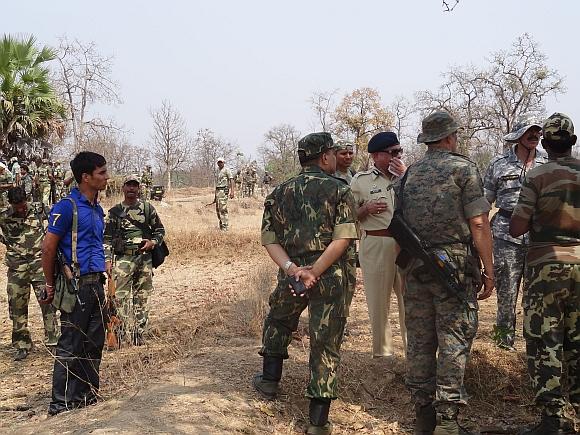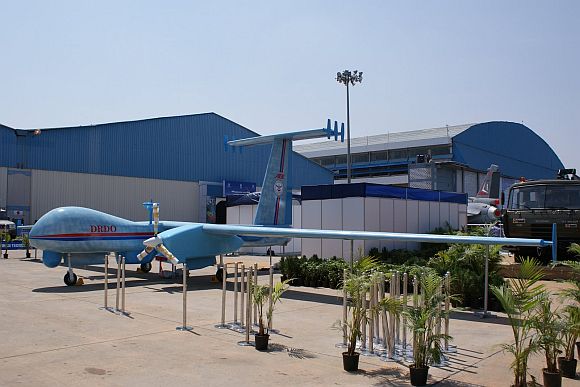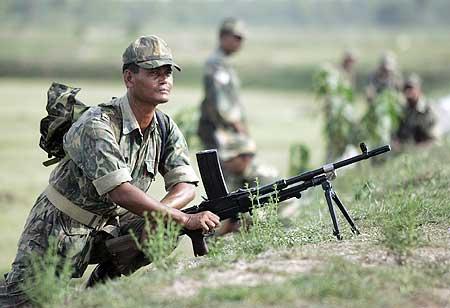Photographs: Sahil Salvi/Rediff.com V Balachandran
Fancy solutions by armchair experts are of no use to thousands of valiant CRPF jawans and local police who are fighting lone battles, says retired IPS officer V Balachandran
Tucked away in a corner was a news item in our newspapers (April 10, 2013): '13 acquitted in Maoist attack case'. For the visual or print media this disappointing result was not as newsworthy as the triumphant entry of Chief Minister Narendra Modi into Kolkata.
Publishing the court verdict in one of the worst Maoist massacres at Chingawaram in Dantewada district on May 17, 2010, in which 31 persons including 15 security personnel were killed in a passenger bus would not have earned the visual media so many Television Rating Points. Also unnoticed was that the same Dantewada judge had acquitted 10 accused in January this year in the 'Tadmetla' massacre in which 76 security personnel were killed on April 6, 2010. The Chingawaram killing came barely 40 days after Tadmetla when private bus operators refused the Maoist order prohibiting the carrying of security personnel as passengers.
Then came the Dhauri massacre (Narayanpur district) on June 29 in which 27 CRPF men were killed. As many as 43 witnesses turned "hostile" during the Tadmetla trial, indicating the level of Maoist terror in the region. A newspaper recently said that insurgents have been showing the Tadmetla attack video films in remote tribal villages "to flaunt their military power" for more recruitment.
Another report (April 8) said that Naxals had trained four batches of 30 to 35 trainees in combat operations, military intelligence and assaults. Thus, fancy solutions advocated by our "armchair experts" far removed from the dismal ground reality, can be of no use to thousands of our valiant CRPF jawans and local police who are fighting lone battles.
...
How other nations tackled the Maoist threat
The problem is that much of this type of experience we can study was during an era when human rights bodies did not breathe down the necks of security forces as is now happening. Secondly, in all other experiences, whether Hukbalahap in Philippines, Malayan, Mau Mau or Colombia, the success was achieved with a unified command of security forces which in India is difficult to achieve with the present trust deficit between the Centre and states who are already in 2014 poll mode.
This squabble permeates down to even security professionals as we saw between the Chhattisgarh director general of police and the Central Reserve Police Force, which was too shameful for any comment. The third lesson we would learn from other countries is that this overall commander for security operations should also be in charge of development activities, which is unimaginable in Indian conditions.
After the Japanese ended their occupation in Philippines (1942) 6,000 sq miles of the richest rice growing area in Luzon, called as Huklandia, it came to be dominated by the Hukbalahap (Huks for short), a united front of Communist peasants. At the peak of their rebellion they commanded 15,000 guerrillas and 1,00,000 clandestine members.
In 1951, Ramon Magsaysay was appointed as secretary, National Defence, under American advice as Overall Commander of the army and police and development activities. He organised small combat teams which penetrated more effectively into Huklandia, denied food supply to insurgents, built 300 miles of new roads, dug 2,000 wells in four years, exchanged good officers between army and police, raised a dedicated intelligence corps, suspended habeas corpus in conflict areas, offered handsome rewards and resettled surrendered families with land. By 1953, the number of Huks who surrendered to the government (15,866) was larger than the numbers who were captured (4,269) and killed (9,695) combined.
The Malayan Communists (CPM or Communist Party of Malaya) also followed the Indian Maoist classical doctrine of war in three stages: Lightening attacks, 'Liberated Zones' culminating in 'Mobile War' by hitting high quality targets with the ambitious plan of capturing the country. They wanted the disruption of economy by paralysing rubber cultivation and mines. The Malayan Peoples' Liberation Army with a strength of 8,000 killed 1,865 security forces and 2,479 civilians (1948-1960). The MNLA suffered 6,711 casualties, 1,289 were captured while 2,704 surrendered.
However, there were several dissimilarities between these two cases. Unlike Indian Maoists, who indoctrinated original residents like Adivasis and villagers, the CPM's pool was the migrant Chinese labour imported by the British for rubber / palm oil plantations and tin mines from 1877. This was an advantage for the colonial administration as they could use the original residents against the Chinese.
When Japan invaded Malaya in December 1944, they killed 80,000 Chinese and pushed them into the forest as squatters. In 1945, the Japanese were defeated and the CPM started secretly planning to take over Malaya. In the beginning the British also downplayed its seriousness like our former Home Minister Shivraj Patil. They described it as "emergency" not to upset London commercial insurance rates on which the Malayan commerce and industry depended.
The administration used the 'Briggs Plan' and 'Templer Plan' to tackle this problem. The Briggs Plan was (a) denying food to insurgents provided by Chinese squatters; (b) resettling 5,00,000 squatters; (c) raising an aboriginal force 'Senoi Pra'ak' to kill insurgents; (d) building landing strips and police posts in remote areas and (e) issuing national identification and ration card system to isolate insurgents. By 1952 they had resettled 4,23,000 Chinese squatters in 410 new villages.
They ceased to supply food to insurgents as they became property owners. This "resettling" was copied, albeit poorly, by the Chhattisgarh government.
High Commissioner Sir Gerald Templer increased police strength by 700 per cent, recruited 20,000 Home Guards with shotguns, opened schools, clinics and police stations and achieved massive village electrification. He also punished those who helped the insurgents by cutting their rations, closing schools and ordering curfew. Psy War was used with great efficacy.
The 'Information Services Department' kept Malayans informed of Communist atrocities. They replicated the CPM strategy of indoctrinating villagers by jumping ahead of them. Before the CPM could reach a village this staff would go and explain what the government was doing. About six million leaflets were circulated every month to counter CPM propaganda. The most innovative scheme was using high-powered loudspeakers (Stentor, Magnavox and Thunderer amplifiers on armoured vehicles with 2-3 miles range) to boom into the jungles. Mark 4 Auster aircraft and Dakotas with four loudspeakers of 500 watts would boom into the jungles with great effect since the "Thundering" from the sky had a delirious effect on villagers.
Like in Philippines the British fought insurgency using a unified strategy. No martial law was proclaimed. In 1948, the police deployed 12,000 men assisted by the army's 5,000 men. The total number went up to 40,000 later. Military officials were drafted into the Special Branch.
The Mau Mau rebellion, which was provoked by the British land-grabbing, went through different stages: First they used repressive tactics through the heavily armed 24,000 strong Home Guards who used to shoot at sight, burn the villages and deny food. All Kikuyu, Embu and Meru were forced to shift to concentrated villages, near the Home Guard bases.
This was changed in 1954 when a dialogue with Jomo Kenyatta who was in prison started. It resulted in good outcome. That was not the case in Colombia. The situation which was showing some hope when President Alvaro Uribe (2002-10) had put the National Police in charge of counter-terrorist operations is now causing a lot of worry. The deadly Civil War (La Violencia) of the 1940s led to the Communist insurgency by FLN (National Liberation Front) and FARC (Revolutionary Armed Forces of Colombia) while the AUC (United Self-Defense Forces of Colombia), the landowners' right wing militia, opposed them. Drug cartels started helping the insurgents from the 1980s.
In the 1990s the government was combating 107 rebel fronts or 20,000 insurgents. The FARC had nearly 18,000 armed men in 2010. In 2008 they were controlling nearly 30-35 per cent of the land area, especially the 5,00,000 sq km of jungles. The problem is that the FARC, which is considered a terrorist organisation by Colombia, USA and European Union, is not treated so by Colombia's neighbours like Venezuela, Brazil, Argentina, Ecuador and Nicaragua.
Like our Maoists who want all police operations to cease in their "areas", the FARC has succeeded in bringing about international pressure to compel the current President Santos to recognise that there is "an armed conflict" in the country. Effectively the country is divided between the zones controlled by the government and FARC. This is not a model for us to copy.
...
What we have been doing in India
Image: Rustom-1, a medium altitude long endurance Unmanned Aerial Vehicle, used in combing operations against MaoistsWhere do we go from here? First, we have to admit that we have no effective Maoist policy except sound bytes beginning with our prime minister's address to the state DGPs on November 4, 2004, that 'Maoists constituted an even greater threat to India than militancy in Jammu and Kashmir and North-east'. The only time when some organised activity was witnessed was when Home Minister P Chidambaram (2008-12) had initiated firm measures through Director General Vijay Kumar who was in charge of CRPF.
Some of the recent steps are sanctioning Rs 280 crore for raising the elite anti-Naxal forces in Bihar, Jharkhand, Chhattisgarh and Odisha states on the lines of the Andhra Greyhounds and deployment of UAVs. While this is good news I was also saddened by another report that in Jharkhand, most of the police officers, including IPS officers "cannot shoot straight" as revealed during a recent firing practice. The report also said that 'thousands of police personnel in the state have not fired a single shot in four years'. It is learnt that UAV Predators, described as "game changers" to locate Maoists in the jungles, have not yet been used.
Even if they locate the targets, how do we deal with them when we cannot rush through the hills and jungles to engage them, as by the time the Special Forces reach the insurgents would have vanished? We cannot replicate the US drone strategy of using remote controlled missiles fitted to drones to strike at targets.
...
What we need to do
Image: A paramilitary soldier mans his position before proceeding inside the villages of LalgarhPhotographs: Jayanta Shaw/Reuters
Now that all political parties are in 2014 election mode, I would recommend the following agenda for the next government:
Do we want to eradicate the Maoist menace and bring the whole country under the rule of law? Or do we want the Colombian situation where the federal government has tacitly acknowledged the FARC's rule and ceded territory?
We should abandon the fiction that development, to be carried out by other agencies, will go hand in hand with police action. As long as the Maoist cadres are able to strike unseen terror, they will allow no such activities unless there is a unified command for both.
A political consensus should be arrived at between all parties, that we need an agreement to change the present constitutional arrangements which hinder effective centralised operations. The present squabble over Centre-state on policing should stop. If a Maoist affected state achieves better law and order with central help, the result will be for the benefit of the opposition ruled government too.
This cannot be achieved unless there is a political agreement that the present character of state administration in insurgency-prone areas needs to be recast at least temporarily to establish an administrator who will be in overall command of policing and development activities. The agreement should be to implement the essence of recommendations in Chapter IV (Internal Security) by the National Democratic Alliance's Group of Ministers (GOM-February 2001) on Emergency Provisions under Article 352, 353, 355 read with the Punchi Commission's (Second Commission on Centre-state relations) recommendations to amend Articles 355 and 356 "to bring specific trouble-torn areas under its rule for a limited period" and "localising Emergency Provisions -- either a district or part of a district" instead of the whole state. No ego will be bruised since the GoM's recommendations were made when the present opposition NDA was in power.
Similarly, the Congress-led United Progressive Alliance will be happy that the recommendations of Punchi Commission set up by them would be followed. The new government could copy some of the provisions of the Armed Forces Special Powers Act 1958 and empower the central forces in the specified area. A political agreement should be arrived at making this a temporary measure to bring civil administration and law and order in the concerned areas under an overall commander who could even be a nominee of the concerned state government. The opposition-ruled states need not fear central encroachment in their states since the rest of the areas not affected by the insurgency would be ruled by them.
What is needed is statesmanship and not petty egos which is now hindering national security.
The writer is a former special secretary, Cabinet Secretariat. He was also part of the two-man 'High Level Committee' appointed by the government of Maharashtra to inquire into the police performance in the 26/11 Mumbai terror attacks.





article